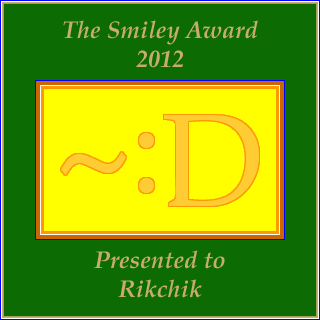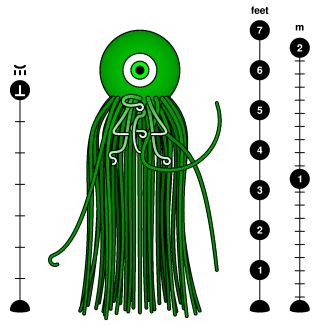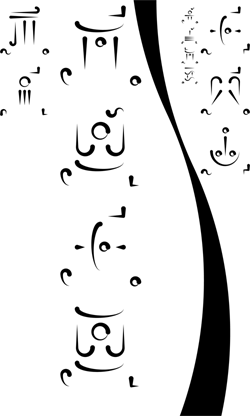The 2012 Smiley Award Winner: Rikchik
I am very pleased to present the 2012 Smiley Award to Rikchik, an exolang par excellence developed by Denis Moskowitz. Rikchik is, without a doubt, the most alien alien language ever created, and I'm delighted to present it with the Smiley Award. Congratulations, Denis!

http://suberic.net/~dmm/rikchik/language/language.html
What's a Rikchik?
If you know absolutely nothing about Rikchik, then you might be taken aback by my statement that Rikchik is the most alien exolang ever created. "But Klingon has OVS word order!" you may say (and indeed it does). And while that's quite rare amongst natural languages on Earth, the language is about as alien as dyed hair when compared to Rikchik. How so? Let me introduce you to the "speakers" of Rikchik: the rikchiks. They look like this:

According to Denis, rikchiks are about two meters in height and have 49 tentacles, 7 of which are shorter than the others and can be used for fine manipulation. They're green, have a great big spherical globe that contains most of their organs, and have one gigantic eye.
Oh, yeah, and they can't hear or consciously produce noises on par with our speech sounds.
So how do they communicate? By manipulating those 7 shorter tentacles, they can use a sign language that isn't even human-usable, save in its written form (unless you happen to have been born with seven tentacles that you can manipulate the way rikchiks do). I don't think it's a language that can even properly be modeled in real time save through animation.
And that, of course, is just the beginning.
Making the Most of the Medium
Having really, really alien aliens is probably enough for most conlangers to say, "Huh. That's interesting" to Rikchik and move on. One of the things that makes Rikchik so neat, though, is how Denis has used the medium he's created to do something linguistically interesting that you couldn't do with a spoken language.
To give an analogy with something slightly more familiar, in a manual sign language like ASL, the active articulators are the two hands (and occasionally the lips and eyebrows and head), with passive articulators all around the body. Movements (both primary and secondary) are also used grammatically, so that two words can differ based on the shape of the hands, where on the body they're signed, where the hands move, where they face, and/or how the hands themselves move (whether stationary or not). Changing any of the elements has the potential to change the class of the lexeme, the lexeme itself, or its part of speech.
Rikchik, by comparison, uses less potential articulatory material. Since the seven "speaking" tentacles are much shorter than the others, the placement of a sign itself simply isn't a factor—it isn't used to distinguish between signs. Instead, only the placement of the tentacles with respect to one another is phonemic (or grammatical). In addition to this, all Rikchik signs are static—that is, aside from the tentacles needing to move to go from one sign to the next, movement is not a phonemic (or grammatical) feature of the Rikchik language. This leaves only "handshape" (i.e. tentacle shape), order and internal composition to distinguish signs. This might make Rikchik seem less expressive than a human manual language, but that turns out not to be the case.
See, if one compares the seven Rikchik "speaking" tentacles to a human hand, the tentacles are far more versatile. While we have five fingers on one hand, there's only so much we can do with each finger independently. A rikchik's tentacles are rather more like arms, though, which means that each one can be moved independently. Denis has used this to his advantage by breaking the seven "speaking" tentacles into smaller groups, which, for ease of reference, I call the lexical tentacles (a group of four tentacles) and the grammatical tentacles (a group of three). On his site, the writing system Denis has developed distinguishes (optionally) between the two groups by coloring the lexical tentacles black and the other tentacles either blue, green or red, depending on their function (more on that below). Here's an example:

The black tentacles in the middle tell you that the word has something to do with movement. The rest tell you specifically what it has to do with movement and what role the word plays in the rest of the clause (something that's meaningless when the word is used in isolation, but we'll see some sentences in a bit). By analogy, this would be kind of like saying that on the right hand, the pinky always told you whether something was a noun or a verb, the index finger what case, and the thumb the number. Isn't that ingenious!
Familiarizing Oneself
Understandably, taking a look at Rikchik can be intimidating, since at first blush there's very little that's relatable to a human being. If you let that get to you, though, you'll miss a lot of neat details, so let me try to break it down a bit and identify some elements that conlangers, at least, should be quite familiar with.
Rikchik, like the Bantu languages, has noun classes. One of these noun classes is a verb class, but this is actually quite common in languages with noun classes. The phenomenon is pretty easy to spot straight off if you see an example (this one comes straight from the Rikchik site):
 |
 |
 |
 |
| Home | Family | House | Marry |
As you can see, a rikchik simply alters the shape of the grammatical tentacle on the lower left (colored red) to change the class of the word. There are seven of these word classes, and they can be described roughly thus:
 The Inanimate Class: For objects, etc.
The Inanimate Class: For objects, etc. The Animate Class: For living beings and things which seem to be alive or mobile (such as rivers and self-driven vehicles).
The Animate Class: For living beings and things which seem to be alive or mobile (such as rivers and self-driven vehicles). The Place Class: For physical and figurative locations (e.g. time periods).
The Place Class: For physical and figurative locations (e.g. time periods). The Idea Class: For abstracts.
The Idea Class: For abstracts. The Verb Class: For verbs and actions.
The Verb Class: For verbs and actions. The Modifier Class: For descriptors or descriptions.
The Modifier Class: For descriptors or descriptions. The Name Class: For names and for words whose meanings aren't being used literally in compounds (think "pea" in "peanut").
The Name Class: For names and for words whose meanings aren't being used literally in compounds (think "pea" in "peanut").
If you're a conlanger, this should strike you as immediately familiar, and should make navigating Rikchik a bit easier. Now check out some of the cool sets of words Denis has come up with using this system (most of these are only partial paradigms; for more, check out the Rikchik lexicon):
 |
 |
| Sleep | Nowhere |
In other words, the "sleep place" is the actual deictic word you use to mean "nowhere". Ha! (Full Lexeme)
 |
 |
| Crab | Dead Crab |
This is actually one instantiation of a pattern that holds generally. If you tag an animal sign with the Animate class, it's the canonical version of that animal (alive, healthy, running or bobbing about, etc.); if you tag it as Inanimate, it's the dead version of that same animal. (Full Lexeme)
 |
 |
 |
 |
| Fruit | Picked Fruit |
Create | Magenta |
First, it's easy to see the live animal/dead animal paradigm in action here, but there's also a metaphorical extension in "create", and further, we learn what the usual color of vegetation is on the rikchik home world. (Full Lexeme)
 |
 |
 |
| Share | Equal | Divide |
I don't know how many conlangs have a lot of mathematical terminology, but Rikchik actually has a full complement, and it gets its terms from interesting sources—such as the word for "division" which comes from the same root as "share". (Full Lexeme)
 |
 |
 |
| Eye | See | West |
The first two are probably not surprising, but for the latter, perhaps "west" is the canonical direction a rikchik faces (it being, of course, the best cardinal direction). Interesting! (Full Lexeme)
There's more to discuss, but my hope is this will help the reader to orient themself. Nouns are usually the easiest thing to get a hold of, so now you've got a base for us to look at the rest of the language.
Putting Things Together
We've seen what the red grammatical tentacle does. Now let's look at the other two.
Though the mapping isn't exact, you can think of the blue tentacle on top as the case marking tentacle. In fact it marks thematic roles and some other things (for example the little blue circle which we've seen a lot of simply marks the end of a sentence). It determines what basic function a given lexeme plays in a sentence, with a verb often further refining that role. Here's a list of the Rikchik relations:
 Source: The cause of an action or origin point of a action or movement.
Source: The cause of an action or origin point of a action or movement. Agent: The subject of an action verb (the one that performs an action).
Agent: The subject of an action verb (the one that performs an action). Quality: Used with modifiers (or adjectival or adverbial).
Quality: Used with modifiers (or adjectival or adverbial). Instrument: The implement by or through which an action is accomplished.
Instrument: The implement by or through which an action is accomplished. Patient: The one that undergoes or is affected by some sort of action.
Patient: The one that undergoes or is affected by some sort of action. Destination: The destination of a movement or action.
Destination: The destination of a movement or action. Includes: The container of an object or location of an action (commonly referred to as the Location in linguistics).
Includes: The container of an object or location of an action (commonly referred to as the Location in linguistics). End: Cooccurs with the end of a clause.
End: Cooccurs with the end of a clause.
Now here's the part where it gets a little difficult. The green tentacle in the lower right-hand corner of a given glyph is what's referred to as the "collector". The collector itself is simply a number, and that number defines a given clause. Most of the collectors we've seen thus far are little green circles, which are, in fact, the number zero. If one is simply throwing up a sign as an example, the zero collector is the one one would use (a kind of default, since it's a word without a clause). If there were a different number there, though, it would specify that the number of signs which preceded it are all a part of one clause. As a result, if one of those signs bore the agent role (with a verb bearing a collector of three at the end, let's say), it would be the agent of the clause defined by those four signs (the collector doesn't count itself, so if there are four total signs, the last one will collect the previous three and bear the "three" collector, not four).
This might be a bit confusing, so let's see an example. Here are some glyphs to start with:
 |
 |
 |
| Fish | Human | Love |
Now let's put them into some sentences!
| (A) | (B) | (C) | ||
 |
 |
 |
Here are the corresponding translations:
- The human loves the fish.
- The fish loves the human.
- The fish is in love on or inside the human.
First notice that all three have the "love" sign in common. The black and red tentacles define it as the verbal concept of "love"; the blue tentacle indicates that this sign is the end of a clause; and the green tentacle is a number two, which indicates that the verb "collects" the previous two glyphs. The differences, then, come in the blue tentacles on "human" and "fish". In (A), the human is the lover and the fish the lovee; in (B), it's the exact opposite. In (C), the fish is still the lover, but the human is the location of the action being described, so what we know is that there's a fish, the fish is in love, and that this somehow happens on or inside the human. It's up to context to determine whether the poor enamored fish is being digested or perhaps doing a merry jig atop the human's head.
Though these are simple clauses, hopefully it gives you an idea how Rikchik discourse works. Basically you get chunked elements with some information until you hit a collector which tells you how to fit together everything that hasn't yet been fit together. It's worth noting that though I used a verb in these example clauses, there is no formal difference between verbs and nouns, meaning that clauses can be put together with or without verbs. And, of course, it goes without saying that this is just a basic introduction. For more, check out the page on collectors.
How Rikchik Has Made Me Smile
Too easy. I mean, come on: This is a language used by gigantic, one-eyed, 49-tentacled green aliens. And Denis and his brother Marc (both wonderful artists) really get into the spirit of it (check out Denis's talk at LCC3 to see some more Rikchik art), acknowledging that it's both cool and silly—and fun! One of my favorite little bits from the site is the picture of a rikchik viewing itself in a mirror:

And check out this Coke ad which I saw for the first time at LCC3:
I love pretty much everything about the style and presentation of the rikchiks and their language. It's both fascinating and charming. Though this write-up has focused on the language, I entreat you to take a look at some of the cultural information Denis has prepared about rikchiks, like the page on rikchik names, the page on their religious practices (very neat!), and, yes, the page on rikchik mating practices. Oh, and as you browse the rikchik site, please take a moment to marvel at the code Denis wrote to automatically generate rikchik glyphs. Those images above? Most of them I built myself, because that's how awesome his site is.
With thousands of conlangs in existence, it's rare to come across one that strays so far from the norm as to be completely unique. Rikchik does just that. It's a wonderful invention, and remains the gold standard for alien conlangs. Thanks for sharing it with us, Denis, and congratulations!


